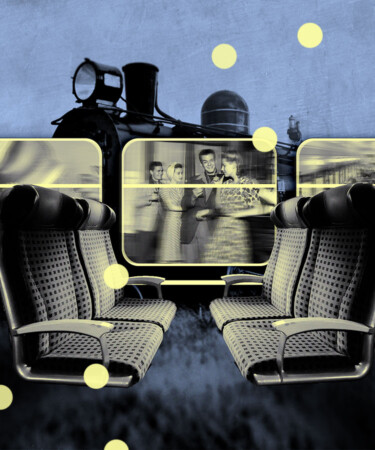From hiding illicit booze in the pockets of oversized jackets to drinking on full-service dining cars, it’s no secret that people love to drink on trains. Though alcohol on locomotives is a common sight — whether smuggled contraband or purchased legally — nothing quite compares to bellying up to your favorite bar and ordering a pint. In the late 1940s, British Rail sought to give its passengers the best of both worlds with the development of the tavern car, a fully functioning pub on wheels that was used on the Southern and Eastern Railway lines.
First displayed in London in May 1949, the tavern car was designed by mechanical engineer Oliver Bulleid, who was thought to have modeled the layout and decor after The Chequers Inn in Pulborough, Sussex. The train cars — refurbished former buffet and refreshment cars — were decorated like traditional English pubs, complete with white washed walls, dark oak beams, narrow, old style windows, and carriage lamps.
There really was a set of railway train pub carriages from Waterloo in the 1940s/1950s – the “Tavern Cars” – here’s the video to prove it pic.twitter.com/JtlDiEMVLB
Don't Miss A Drop Get the latest in beer, wine, and cocktail culture sent straight to your inbox.— Tim Dunn (@MrTimDunn) November 17, 2017
The cars’ interiors weren’t the only thing to be redesigned; the exteriors of each tavern car were completely rehauled to mimic that of the pub as well. Rather than sheet metal in one solid color, the exteriors of the train cars were built in a mock-Tudor style, divided horizontally with the top half of the car a cream color and the bottom half consisting of fake brick to mimic the facade of England’s pubs.
Each of the eight “pub” cars was then given the name of a classic English pub: The Jolly Tar, The White Horse, The Salutation, The Dolphin, The Bull, The Green Man, The Crown, and The Three Plovers. Each one even had a sign denoting its name.
Though an exciting prospect, the development of these pub cars was quite an expensive undertaking and faced immediate criticism, namely from the British House of Commons. In total, the development of the train cars cost approximately £64,000 — approximately $3.5 million in today’s dollars — eating up approximately 25 percent of the British Rail’s total budget of £281,000, about $12.7 million today.
In a June 1949 parliamentary session, Tom Drigberg proclaimed: “Words fail me to express the full horror which I felt when the announcement was made by [British Rail] of the cars which they described as being ‘mock Tudor style.’” Drigberg was not the only MP to denounce the appearance of the tavern cars, with the general consensus being that they were simply “shoddy Tudoresque monstrosities.”
They were not universally loved; note these letters addressed to the Editor of @thetimes in 1949 berating British Railways for its Tavern Cars. The heads of the @V_and_A, @theRSAorg @ICALondon were not impressed! pic.twitter.com/MZ0N3iz98V
— Tim Dunn (@MrTimDunn) March 27, 2020
Those in the British government were not the only people with gripes over the traveling pubs, as revealed in a letter of protest published in The Times. “As an American visiting England to study present tendencies in the union of art and industry, I have just come face to face with British Railways’ new tavern car. It is somewhat disquieting to imagine oneself propelled through your lovely countryside in a conveyance walled in by painted bricks and held up with half timbers,” the letter reads. “Why does the railway administration not make use of such excellent, progressive bodies as the Council of Industrial Design before ‘experimenting’ with the traveler’s well-being?” The letter was signed by heads of London’s Victoria and Albert Museum, Royal College of Art, Council of Industrial Design, and Institute of Contemporary Arts.
While tavern cars were generally enjoyed by the public — as parliamentary secretary to the Ministry of Transport James Callaghan MP pointed out in his oppositional opinion, “Nobody likes these tavern cars except for the public” — complaints surrounding the claustrophobic nature of the cars quickly surfaced. The windows, which were narrow and placed near the roof of the carriages, made the room itself feel smaller while the lack of ventilation made for an uncomfortable and stuffy atmosphere, especially during the summer months.
Just one year after the tavern cars were first announced, British Rail was forced to pivot in terms of design, removing the Tudor-style brickwork from the external walls and adding more windows to aid with light and airflow. By 1959, the transportation network had spent approximately £23,000 (about $1.2 million today) transforming all traveling pubs back into conventional dining cars.
Though tavern cars may no longer be around today, for one magical decade travelers could zip through the English countryside at speeds 60 miles per hour while sitting in one of their favorite pubs — or at least a rendering of it.
